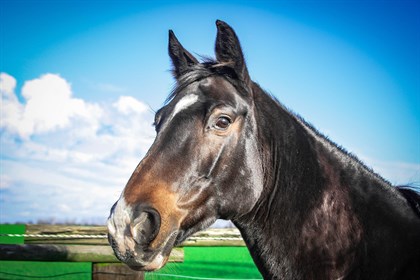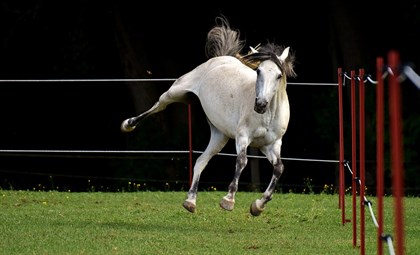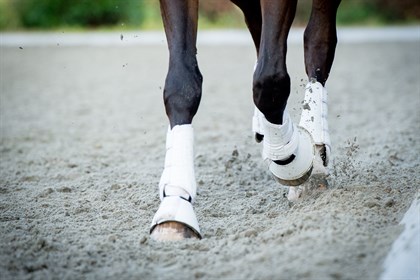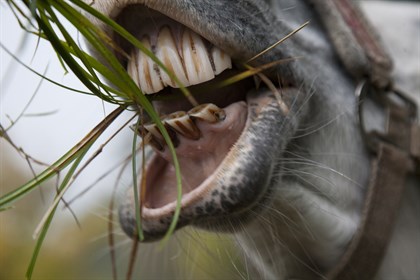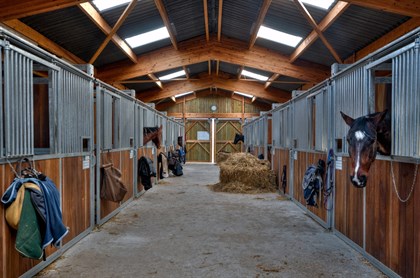
This article has appeared previously with Equestrian Life. To see what's in our latest issue, please click here.
Horse ownership is rewarding and exciting.
By Dr Tessa Muir
Owning a horse, whether as a beginner or experienced rider, the one commonality is that at some point, you are likely to need the services of a vet. But, many of the most common calls vets receive turn out to hinge on a lack of understanding of the most basic signals that every horse owner should be aware of. Equine veterinarian, Dr Tessa Muir, provides a quick reference guide that can inform how you deal with treatment.
Horse ownership is rewarding and exciting. However, to ensure your experience is a good one you need to carefully consider the many important responsibilities that come with owning a horse. What is presented here are a few basic facts you should know about your horse and that provide a quick reference guide to keep and refer to whenever the need arises. It is not designed to be an exhaustive list, but everyone from the first time owner to the Olympic champion, should know and remember these important facts. The range of experience between horse owners is vast and such a guide can be useful as a refresher or to help inform new owners about what is normal, or not. A clear understanding of the basics will help you recognize promptly when things go wrong. It will also help when you do call a vet and can clearly relate issues or symptoms, so your vet knows how quickly they must arrive.
Owning a horse, whether as a beginner or experienced rider, the one commonality is that at some point, you are likely to need the services of a vet.
VITAL SIGNS
HEART (PULSE) RATE - 28-44 beats per minute
BREATHING RATE - 12-16 breaths per minute for a horse // 20-24 breaths per minute for a pony
TEMPERATURE - 37.0-38.5 oC
MUCUS MEMBRANE (GUMS) COLOUR - Pink and moist
CAPILLARY REFILL TIME - Less than 2 seconds
Knowing the reference range of vital signs is one of the most basic things an owner should know, but it is amazing how often these key values are forgotten, particularly during a stressful situation. The values above indicate the range for the average adult horse; familiarise yourself with what is normal for your particular horse by checking and recording these values regularly. If you don’t know how to perform this basic clinical examination ask your vet to show you next time they visit as it can give you, and your vet, some very useful indications of how serious a particular problem might be. Any horse that appears suddenly ‘under the weather’ should be examined and you will be able to note any changes and alert your vet.
TIP: Record these values and have them displayed somewhere visible or where you have easy access to them.
WATER
Average water intake for a 500kg horse in mild weather is 25L per day
The water requirement for an average adult horse is 50ml per kg per day. You can work out the average water intake for your horse using the following equation and filling in the blanks.
0.050ml x ______________ (horse weight in kg) = _________________ (total per day in L)
Remember: This is the amount of water required on a mild day.
Questions relating to water intake are relatively common and can be tricky to answer because there are so many variables. Water is crucial to a horse's survival and of primary concern is that horses have access to fresh, clean water at all times. Horses are similar to humans and their requirements for water changes depending on a number of factors including temperature, exercise and other available sources of water. Australia has a varied climate, therefore water intake will fluctuate depending on the season. While temperatures are often very high, particularly during the summer months, the amount of water your horse drinks is likely to exceed the average 25L for a 500kg horse and during the milder months, such as spring, horses can attain water through eating moist grass and this can reduce the horse's desire to drink. Another consideration is exercise. While a horse resting in a paddock may not require extra water, a horse being ridden is likely to have an increased requirement.
If your water supply is not self-filling you must fill it up regularly. But, even self-filling devices must be checked regularly for faults that inhibit flow. Similar to humans, horses can go without food for a prolonged period, but become seriously ill or die without water after a short period. Stagnant water should never be the only available source of water, particularly in warmer weather, as it can be full of bugs that are not good for your horse’s health.
A lack of water leads quickly to dehydration and it is important that you are able to recognise the signs before any serious side effects occur. An easy way is to look for signs such as leathery, dry ‘tacky’ gums, excessively thick saliva and sunken eyes. Another simple test is the 'skin pinching test' and while not always accurate, it can be used together with other signs to alert you to a potential problem. Pinch a fold of skin on the horse’s neck and release it. It should immediately return back to its natural position. If not it can be a sign that your horse is dehydrated. A horse that is dehydrated should be offered water. If they are disinterested but still appear dehydrated, call your vet who can discuss options to correct the problem.
TIP : ENSURE ALL WATER SUPPLIES ARE FIRMLY STABILISED, SO THAT THEY CAN’T BE TIPPED OVER. HORSES QUICKLY BECOME SICK IF THEY DON’T HAVE ACCESS TO WATER, PARTICULARLY IN HOT WEATHER.
FOOT CARE
Horses need their hooves trimming every 6-8 weeks (average)
All domesticated horses need their hooves trimmed to ensure their feet remain well balanced and free of cracks. Shoes are not always a requirement and it is important to discuss with your farrier what you require your horse to do as they will then be able to advise you.
In between visits it is your responsibility to keep your horse's feet healthy. Pick them out and clean them with a hoof pick daily, or as often as possible. Examine the foot and note any bruising or bad odour. This is not normal and you should consult either your farrier or vet if you notice anything unusual.
TIP: A GOOD FARRIER IS VERY IMPORTANT. MANY LAMENESS ISSUES RELATE TO POOR FOOT BALANCE AND SHOEING.
It is your responsibility to keep your horse's feet healthy.
WORMING
Many worming pastes require use every 6-8 weeks
De-worming in horses is a contentious issue and there is a lot of confusion about how and when to worm a horse correctly and effectively without increasing the risk of resistance. A good rotational strategy is paramount to slow the development of resistance and ensure a worming schedule is effective. Regular worming is an important part of your health schedule because it prevents worms building up in the stomach and intestines. If uncontrolled, these worms can cause disease, particularly in very young or old horses. Follow the directions for the particular product you choose and consult your vet about your horse’s specific requirements. There are a few simple rules to help guide your worming schedule.
RULE 1: Change your wormer once a year – use one class of active ingredient for an entire year before switching to a different class of active ingredient. Look at the box as for most worming products the main active ingredients are either end in ‘mectin’ or ‘azole’.
RULE 2: Regularly remove manure in your horse paddock as this is a simple way to reduce worm contamination of pasture.
RULE 3: Follow the recommended schedule for the particular product you chose. If you are unsure consult your vet.
NUTRITION
On average a 500kg horse needs 5-10kg of roughage per day
Feeding your horse to ensure it remains healthy is paramount. While every horse will have different requirements, depending on living environment and level/type of work, there are a few basic rules and requirements. Both obesity and lack of nutrition can lead to serious illness. Remember that your horse's dietary requirements may vary, and you need to adapt the diet based on work load, age and time of year (particularly if they get the bulk of their feed through pasture). Mature adult horses in light/moderate work can maintain good body condition with good quality pasture. Supplementary feed, such as good quality hay, is usually required only when pasture is sparse and of poor quality.
On average a 500kg horse needs 5-10kg of roughage per day.
RULE 1: Regularly assess your horse’s body size, appetite and condition and adjust diet as required. If you are unsure about what is the right body weight seek professional advice.
RULE 2: All horses must have access to good quality feed in the form of roughage – minimum roughage intake is 1kg/100kg bodyweight. This is vital to maintain digestive function. Horses naturally graze for most of the day.
RULE 3: Do not make sudden changes to your horse's diet, but introduce changes over a period of 1-2 weeks.
RULE 4: Feed consistently at the same time every day - horses are creatures of habit.
RULE 5: Feed foods appropriate for your individual horse – there are numerous complete diets available for a range of different horses. Talk to an expert who can give you the right advice for your particular circumstances.
RULE 6: Mineral supplementation is important, so make sure your horse has access to a salt block.
RULE 7: Beware of periods of rapid grass growth – lush grass is a common trigger for laminitis, particularly in already over-weight ponies. Talk to your vet about ways to prevent laminitis as the condition is difficult to control and the outcome is not always favorable.
TIP: Don’t feed hay or grain that smells bad or appears mouldy or dusty.
TEETH
Horses have a type of tooth that continually grows throughout its life. Young horses' teeth grow faster than adult horses and they loose their milk teeth, similar to children, and therefore need regular attention. The growth is finite in old age. As horses age their teeth become less effective for grinding and processing food and visits from the dentist may be less frequent. In addition, you may need to alter the diet to accommodate this. Below is a table outlining the average time between dental check ups.
This should be used as a general guideline; your dentist will discuss any individual needs. It is important if you notice signs that may indicate an issue. These include dropping food when eating; “quidding” or evading the bit and; head tossing when being ridden. If your horse has any abnormalities - e.g. conformational defects relating to its mouth - your dentist will advise on the interval between visits. The average pleasure or light performance horse that enjoys a significant amount of forage in their diet should not require more frequent check ups.
| AGE | ENVIRONMENT |
TIME INTERVAL BETWEEN DENTIST VISIT |
| › 5 YRS | Paddock | 6 months |
| › 5 YRS | Stable | 3-4 months |
| › 5 YRS | Paddock | 12 months |
| › 5 YRS | Stable |
6 months |
| › 20 YRS | Paddock/Stable |
Varies up to 2 years |
COLIC
Colic is a symptom, not a diagnosis. Not all cases of colic will require surgery but you should seek veterinary advice.
Colic is a term used to describe abdominal pain in the horse; it is a symptom rather than a definitive diagnosis of a particular disease or illness. The signs of colic can vary from flank watching - where a horse intermittently turns its head to look at its belly - pawing the ground and even violent and continuous rolling. It can often be quite frightening for an owner to see a horse with colic as in severe cases a horse may appear very distressed and be moving around in a very violent manner.
If your horse is showing signs of discomfort and you suspect colic, a basic clinical examination can be very useful. If it is safe for you to do so, then by checking gum colour and taking a heart and respiratory rate can help determine the urgency of veterinary attention. Very violent and persistent discomfort should be considered a veterinary emergency and professional help sought as quickly as possible. Prior to the vet's arrival, note whether normal droppings have been passed during the preceding hours. Many cases of colic are uncomplicated and can be relieved with simple medical intervention, but colic can be very serious and indicate a life threatening illness, so call your vet immediately.
WOUND BASICS
Horses commonly get minor cuts and scrapes and usually these won’t pose a serious risk to health. Check your horse daily for any cuts, heat or swelling, particularly on the limbs. If cuts are close to joints or your horse develops lameness after an injury you should seek veterinary attention. Simple cuts and grazes should be thoroughly cleaned with iodine or chlorhexidine based solution to remove dirt and then either bandaged or protected with a topical cream.
TIP: IF YOU ARE UNSURE ABOUT THE SERIOUSNESS OF A WOUND CALL YOUR VET AND DISCUSS THE PROBLEM. IT CAN BE USEFUL TO TAKE PHOTOGRAPHS.
VACCINATION
Vaccinating your horse has associated costs, but this is usually considerably cheaper than the cost of treatment should you horse develop one of the serious and preventable diseases.
Horses are susceptible to a number of serious infectious and non-infectious diseases that cause illness and in some instances death. There is a large spectrum of vaccines available that enhance a horse’s ability to resist infection and therefore help to protect against many of these diseases. Although vaccination minimises the risk of infection, it does not prevent disease in all circumstances. But, it usually reduces the severity of clinical signs significantly. People frequently ask if vaccination is necessary and not all vaccines are appropriate in every situation. Discuss your individual needs with your vet.
In Australia we are fortune that many diseases are not applicable, but you should protect your adult horse against the most important diseases - Hendra Virus, Strangles and Tetanus. Discuss with your vet your particular circumstances, as vaccination schedules will vary particularly for young horses, broodmares and stallions. Below is a table showing the typical vaccination schedule against Strangles and Tetanus.
With the emergence of Hendra virus in Australia it is also important to consider vaccination to protect against this deadly disease. Discuss this directly with your veterinarian who can inform you of the current advised schedule.
TIP: KEEP YOUR HORSE'S VACCINATION RECORD UP TO DATE. MAKE SURE THE CERTIFICATE IS IN A SAFE PLACE SO THAT YOUR VET CAN UPDATE IT EACH YEAR.
| TIME | DISEASE | VACCINATION | FOAL | ADULT HORSE |
| 1ST VACCINATION | Strangles/Tetanus | Equivac 2in1 | 12 weeks age | Any age |
| 2ND VACCINATION | Strangles | Equivac Strangles | 14 weeks age | 2 weeks later |
| 3RD VACCINATION | Strangles/Tetanus | Equivac 2in1 | 16 weeks age | 2 weeks later |
| BOOSTER VACCINATION | Strangles/Tetanus | Equivac 2in1 |
Annually (every 12 months) |
GENERAL HEALTH AND WELLBEING
Owning a horse is a privilege and comes with a lot of responsibility. It is your role as an owner to ensure your horse is well cared for and remains happy and healthy. In addition to the specific issues mentioned in this article you should also consider your horse's general well being.
Horses can either be stabled or kept in a paddock. If in a paddock, you must ensure they have access to good shelter that protects them from the elements. A waterproof rug can be useful in colder months, but must be checked daily for rubbing, slipping or other damage. It can cause more harm than good if not checked on a regular basis. Fencing must be well kept to prevent injury or escape and horses can easily be injured if there is rubbish in the paddock.
If your horse is stabled they ideally should have access to pasture for at least a few hours each day and stables should be well ventilated and clean to prevent associated health problems.
Stables should be well ventilated and clean to prevent associated health problems.
Develop a routine each day that includes observing your horse in its natural environment and a closer examination checking for any signs of injury or illness including unusual heat, swelling or cuts. A happy and healthy horse should be bright, alert and active, with no nasal discharge, a good appetite and well-formed, regular droppings. Being familiar with your horse's individual personality will allow you to notice any issues quickly so that you are able to seek professional advice in a timely manner.
Find a veterinarian who you can build a good relationship with. Your vet should visit at least once a year for a routine check up. If you have any questions make a list. We are used to being asked a range of questions, so don’t ever be too embarrassed to ask. Your vet can help you establish a good quality vaccination; de-worming and general health care plan customised to suit you and your horse's needs.
TIP: INVEST IN A 12 MONTH CALENDAR – WRITE DOWN IMPORTANT DATES TO REMIND YOU OF THE IMPORTANT HEALTH REQUIREMENTS FOR YOUR HORSE.
READ THE LATEST NEWS ARTICLES HERE
https://www.equestrianlife.com.au/articles/Important-basics-for-horse-ownership
